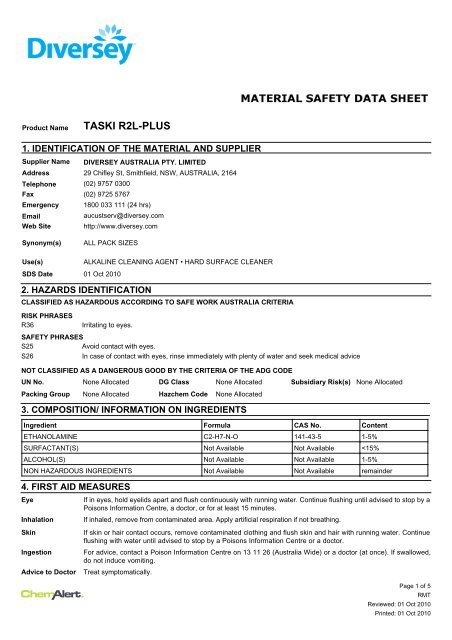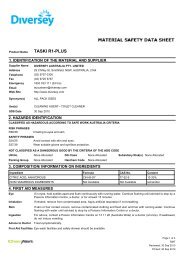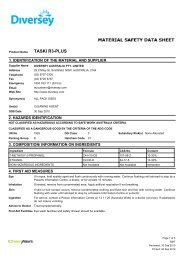MSDS - Taski R2L Plus 2010 - Melbourne Cleaning Supplies
MSDS - Taski R2L Plus 2010 - Melbourne Cleaning Supplies
MSDS - Taski R2L Plus 2010 - Melbourne Cleaning Supplies
You also want an ePaper? Increase the reach of your titles
YUMPU automatically turns print PDFs into web optimized ePapers that Google loves.
Product Name<br />
1. IDENTIFICATION OF THE MATERIAL AND SUPPLIER<br />
Supplier Name<br />
Address<br />
Telephone<br />
Fax<br />
Emergency<br />
Email<br />
Web Site<br />
Synonym(s)<br />
Use(s)<br />
SDS Date<br />
TASKI <strong>R2L</strong>-PLUS<br />
DIVERSEY AUSTRALIA PTY. LIMITED<br />
29 Chifley St, Smithfield, NSW, AUSTRALIA, 2164<br />
(02) 9757 0300<br />
(02) 9725 5767<br />
1800 033 111 (24 hrs)<br />
aucustserv@diversey.com<br />
http://www.diversey.com<br />
ALL PACK SIZES<br />
ALKALINE CLEANING AGENT • HARD SURFACE CLEANER<br />
01 Oct <strong>2010</strong><br />
2. HAZARDS IDENTIFICATION<br />
CLASSIFIED AS HAZARDOUS ACCORDING TO SAFE WORK AUSTRALIA CRITERIA<br />
RISK PHRASES<br />
R36 Irritating to eyes.<br />
SAFETY PHRASES<br />
S25 Avoid contact with eyes.<br />
S26 In case of contact with eyes, rinse immediately with plenty of water and seek medical advice<br />
NOT CLASSIFIED AS A DANGEROUS GOOD BY THE CRITERIA OF THE ADG CODE<br />
UN No.<br />
Packing Group<br />
None Allocated DG Class None Allocated Subsidiary Risk(s) None Allocated<br />
None Allocated Hazchem Code None Allocated<br />
3. COMPOSITION/ INFORMATION ON INGREDIENTS<br />
Ingredient Formula CAS No. Content<br />
ETHANOLAMINE C2-H7-N-O 141-43-5 1-5%<br />
SURFACTANT(S) Not Available Not Available
Product Name<br />
TASKI <strong>R2L</strong>-PLUS<br />
First Aid Facilities Eye wash facilities and safety shower should be available.<br />
5. FIRE FIGHTING MEASURES<br />
Flammability Non flammable. May evolve toxic gases (carbon/ nitrogen oxides, hydrocarbons) when heated to decomposition.<br />
Fire and<br />
Explosion<br />
Evacuate area and contact emergency services. Toxic gases may be evolved in a fire situation. Remain upwind<br />
and notify those downwind of hazard. Wear full protective equipment including Self Contained Breathing<br />
Apparatus (SCBA) when combating fire. Use waterfog to cool intact containers and nearby storage areas.<br />
Extinguishing Prevent contamination of drains or waterways.<br />
Hazchem Code None Allocated<br />
6. ACCIDENTAL RELEASE MEASURES<br />
Spillage Contact emergency services where appropriate. Use personal protective equipment. Clear area of all unprotected<br />
personnel. Ventilate area where possible. Contain spillage, then cover / absorb spill with non-combustible<br />
absorbant material (vermiculite, sand, or similar), collect and place in suitable containers for disposal.<br />
7. STORAGE AND HANDLING<br />
Storage<br />
Handling<br />
Store in a cool, dry, well ventilated area, removed from oxidising agents, acids, nitrites, heat or ignition sources<br />
and foodstuffs. Ensure containers are adequately labelled, protected from physical damage and sealed when not<br />
in use. Check regularly for leaks or spills.<br />
Before use carefully read the product label. Use of safe work practices are recommended to avoid eye or skin<br />
contact and inhalation. Observe good personal hygiene, including washing hands before eating. Prohibit eating,<br />
drinking and smoking in contaminated areas.<br />
8. EXPOSURE CONTROLS/ PERSONAL PROTECTION<br />
Exposure Stds<br />
Ingredient Reference<br />
TWA STEL<br />
Ethanolamine SWA (AUS) 3 ppm 7.5 mg/m3 6 ppm 15 mg/m3<br />
Biological Limits<br />
Engineering<br />
Controls<br />
PPE<br />
No Biological Limit Value allocated.<br />
Avoid inhalation. Use in well ventilated areas. Where an inhalation risk exists, mechanical extraction ventilation is<br />
recommended. Maintain vapour levels below the recommended exposure standard.<br />
Wear splash-proof goggles and rubber or PVC gloves. When using large quantities or where heavy contamination<br />
is likely, wear: coveralls. Where an inhalation risk exists, wear: a Type A (Organic vapour) respirator.<br />
9. PHYSICAL AND CHEMICAL PROPERTIES<br />
Appearance CLEAR DARK GREEN LIQUID Solubility (water) SOLUBLE<br />
Odour CHARACTERISTIC ODOUR Specific Gravity 1.025 (Approximately)<br />
pH 11.0 (neat) % Volatiles NOT AVAILABLE<br />
Vapour Pressure NOT AVAILABLE Flammability NON FLAMMABLE<br />
Vapour Density NOT AVAILABLE Flash Point NOT RELEVANT<br />
Boiling Point NOT AVAILABLE Upper Explosion Limit NOT RELEVANT<br />
Melting Point NOT AVAILABLE Lower Explosion Limit NOT RELEVANT<br />
Evaporation Rate NOT AVAILABLE<br />
Page 2 of 5<br />
RMT<br />
Reviewed: 01 Oct <strong>2010</strong><br />
Printed: 01 Oct <strong>2010</strong>
Product Name<br />
TASKI <strong>R2L</strong>-PLUS<br />
10. STABILITY AND REACTIVITY<br />
Chemical Stability Stable under recommended conditions of storage.<br />
Conditions to Avoid Avoid heat, sparks, open flames and other ignition sources.<br />
Material to Avoid Incompatible with oxidising agents (eg. hypochlorites), acids (eg. nitric acid), nitrites, heat and ignition<br />
sources.<br />
Hazardous<br />
Decomposition<br />
Products<br />
May evolve toxic gases (carbon/ nitrogen oxides, hydrocarbons) when heated to decomposition.<br />
Hazardous Reactions Polymerization will not occur.<br />
11. TOXICOLOGICAL INFORMATION<br />
Health Hazard<br />
Summary<br />
Use safe work practices to avoid eye or skin contact and inhalation. Ethanolamine is irritating to eyes, skin, and<br />
the respiratory tract. Over exposure may result in CNS depression and liver/kidney damage. Persons suffering<br />
from asthma, pre-existing skin disorders, or impaired liver, kidney, or pulmonary function may be more susceptible<br />
to the effects of exposure.<br />
Eye Contact may result in irritation, lacrimation, pain, redness and conjunctivitis. May result in burns with prolonged<br />
contact.<br />
Inhalation Over exposure may result in irritation of the nose and throat, coughing and headache. High level exposure may<br />
result in dizziness, nausea and drowsiness. Chronic exposure may result in kidney, liver and CNS damage.<br />
Skin Contact may result in drying and defatting of the skin, rash and dermatitis.<br />
Ingestion Ingestion may result in nausea, vomiting, abdominal pain, diarrhoea, dizziness and drowsiness.<br />
Toxicity Data ETHANOLAMINE (141-43-5)<br />
LD50 (Ingestion): 620 mg/kg (guinea pig)<br />
LD50 (Intramuscular): 1750 mg/kg (rat)<br />
LD50 (Intraperitoneal): 50 mg/kg (mouse)<br />
LD50 (Intravenous): 225 mg/kg (rat)<br />
LD50 (Skin): 1 mL/kg (rabbit)<br />
LD50 (Subcutaneous): 1500 mg/kg (rat)<br />
12. ECOLOGICAL INFORMATION<br />
Environment Limited ecotoxicity data was available for this product at the time this report was prepared. Ensure appropriate<br />
measures are taken to prevent this product from entering the environment.<br />
Ecotoxicity Not classified as dangerous to the aquatic environment.<br />
Persistence /<br />
Degradability<br />
Limited information was available at the time of this review.<br />
Mobility Limited information was available at the time of this review.<br />
13. DISPOSAL CONSIDERATIONS<br />
Waste Disposal For small quantities, add to a tray of sodium bisulphate. Neutralise and discharge to sewer with large excess of<br />
water. Contact the manufacturer for additional information if larger amounts are involved.<br />
Legislation Dispose of in accordance with relevant local legislation.<br />
14. TRANSPORT INFORMATION<br />
NOT CLASSIFIED AS A DANGEROUS GOOD BY THE CRITERIA OF THE ADG CODE<br />
Shipping Name<br />
UN No.<br />
Packing Group<br />
None Allocated<br />
15. REGULATORY INFORMATION<br />
None Allocated DG Class None Allocated Subsidiary Risk(s) None Allocated<br />
None Allocated Hazchem Code None Allocated<br />
Poison Schedule A poison schedule number has not been allocated to this product using the criteria in the Standard for the Uniform<br />
Scheduling of Drugs and Poisons (SUSDP).<br />
AICS All chemicals listed on the Australian Inventory of Chemical Substances (AICS).<br />
Page 3 of 5<br />
RMT<br />
Reviewed: 01 Oct <strong>2010</strong><br />
Printed: 01 Oct <strong>2010</strong>
Product Name<br />
Additional<br />
Information<br />
TASKI <strong>R2L</strong>-PLUS<br />
16. OTHER INFORMATION<br />
AMINE: CAUTION THIS PRODUCT CONTAINS AN AMINE. DO NOT ADD NITRITES or other NITROSATING<br />
AGENTS to this product due to the potential for NITROSAMINE formation. Nitrosamines are potent carcinogens<br />
and some have been shown to cause severe acute (heart, brain, blood, liver - kidney) damage as well as chronic<br />
effects (reproductive effects, liver - lung and kidney tumours).<br />
RESPIRATORS: In general the use of respirators should be limited and engineering controls employed to avoid<br />
exposure. If respiratory equipment must be worn ensure correct respirator selection and training is undertaken.<br />
Remember that some respirators may be extremely uncomfortable when used for long periods. The use of air<br />
powered or air supplied respirators should be considered where prolonged or repeated use is necessary.<br />
EXPOSURE STANDARDS - TIME WEIGHTED AVERAGE (TWA) or WES (WORKPLACE EXPOSURE<br />
STANDARD) (NZ): Exposure standards are established on the premise of an 8 hour work period of normal<br />
intensity, under normal climatic conditions and where a 16 hour break between shifts exists to enable the body to<br />
eliminate absorbed contaminants. In the following circumstances, exposure standards must be reduced: strenuous<br />
work conditions; hot, humid climates; high altitude conditions; extended shifts (which increase the exposure period<br />
and shorten the period of recuperation).<br />
ABBREVIATIONS:<br />
ACGIH - American Conference of Industrial Hygienists.<br />
ADG - Australian Dangerous Goods.<br />
BEI - Biological Exposure Indice(s).<br />
CAS# - Chemical Abstract Service number - used to uniquely identify chemical compounds.<br />
CNS - Central Nervous System.<br />
EC No - European Community Number.<br />
HSNO - Hazardous Substances and New Organisms.<br />
IARC - International Agency for Research on Cancer.<br />
mg/m3 - Milligrams per Cubic Metre.<br />
NOS - Not Otherwise Specified.<br />
pH - relates to hydrogen ion concentration using a scale of 0 (high acidic) to 14 (highly alkaline).<br />
ppm - Parts Per Million.<br />
RTECS - Registry of Toxic Effects of Chemical Substances.<br />
STEL - Short Term Exposure Limit.<br />
SWA - Safe Work Australia.<br />
TWA - Time Weighted Average.<br />
HEALTH EFFECTS FROM EXPOSURE:<br />
It should be noted that the effects from exposure to this product will depend on several factors including: frequency<br />
and duration of use; quantity used; effectiveness of control measures; protective equipment used and method of<br />
application. Given that it is impractical to prepare a Chem Alert report which would encompass all possible<br />
scenarios, it is anticipated that users will assess the risks and apply control methods where appropriate.<br />
PERSONAL PROTECTIVE EQUIPMENT GUIDELINES:<br />
The recommendation for protective equipment contained within this Chem Alert report is provided as a guide only.<br />
Factors such as method of application, working environment, quantity used, product concentration and the<br />
availability of engineering controls should be considered before final selection of personal protective equipment is<br />
made.<br />
Report Status This document has been compiled by RMT on behalf of the manufacturer of the product and serves as the<br />
manufacturer's Safety Data Sheet ('SDS').<br />
It is based on information concerning the product which has been provided to RMT by the manufacturer or<br />
obtained from third party sources and is believed to represent the current state of knowledge as to the appropriate<br />
safety and handling precautions for the product at the time of issue. Further clarification regarding any aspect of<br />
the product should be obtained directly from the manufacturer.<br />
While RMT has taken all due care to include accurate and up-to-date information in this SDS, it does not provide<br />
any warranty as to accuracy or completeness. As far as lawfully possible, RMT accepts no liability for any loss,<br />
injury or damage (including consequential loss) which may be suffered or incurred by any person as a<br />
consequence of their reliance on the information contained in this SDS.<br />
Prepared By Risk Management Technologies<br />
5 Ventnor Ave, West Perth<br />
Western Australia 6005<br />
Phone: +61 8 9322 1711<br />
Fax: +61 8 9322 1794<br />
Email: info@rmt.com.au<br />
Page 4 of 5<br />
RMT<br />
Reviewed: 01 Oct <strong>2010</strong><br />
Printed: 01 Oct <strong>2010</strong>
Product Name<br />
TASKI <strong>R2L</strong>-PLUS<br />
Web: www.rmt.com.au<br />
SDS Date01<br />
Oct <strong>2010</strong><br />
End of Report<br />
Page 5 of 5<br />
RMT<br />
Reviewed: 01 Oct <strong>2010</strong><br />
Printed: 01 Oct <strong>2010</strong>




